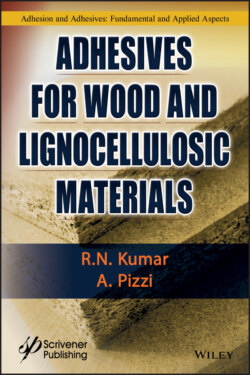Читать книгу Adhesives for Wood and Lignocellulosic Materials - R. N. Kumar - Страница 62
2.10 Equilibrium Contact Angle
ОглавлениеIn 1805, Thomas Young provided the first good approach for describing wettability, spreading, and their relationship to the contact angle.
A drop of adhesive on a surface will come to equilibrium under the action of three forces as shown in Figure 2.5.
Figure 2.5 Equilibrium contact angle based on balance of forces.
Considering the component of γLV along the X-axis, we can write the following force balance:
(2.1)
Thus, when θ = 0, the liquid spreads spontaneously on the substrate; in other words, when cos θ is high (i.e., as it approaches 1), there is spontaneous spreading.
From Equation 2.1, it is clear that wetting will be favored when the surface tension of the liquid is low.
Since the tendency of the liquid to wet and spread spontaneously increases as the contact angle decreases, the contact angle is a useful inverse measure of wetting or the cosine of the contact angle is a direct measure of wetting.
